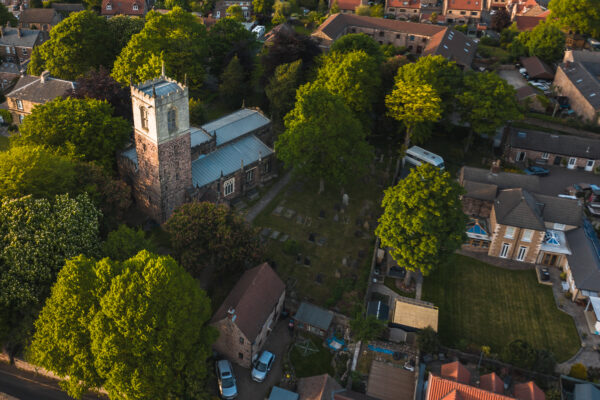Having internet access available to the users of your church building through a WiFi connection can help churches enhance communication, increase connectivity, and foster a stronger sense of community among your members and visitors.
What’s the difference between WiFi and the internet?
The internet is like a big library that has all sorts of information, pictures, and videos that you can look at. But instead of going to the library in person, we use laptops and smartphones to visit the internet from anywhere in the world.
Just like how books in a library are organised in different sections, the information on the internet is organised into different websites. Each website is like a special room in the library where you can find specific things, like pictures of animals or videos of recent Diocesan events.
Being connected to the internet is like being able to enter the library and access all of the information within it. That internet access can be made available wirelessly to multiple electronic devices through a WiFi connection.
What are the benefits of becoming a ‘connected’ church?
There are several potential benefits to having internet access/WiFi in your church building:
- Increased Connectivity: With WiFi, churches can provide internet connectivity to your members, visitors, and staff, allowing them to access the internet, communicate with each other, and stay up-to-date with the latest news and events.
- Enhanced Communication: WiFi can also enable the church to communicate more effectively with members and visitors. For example, church leaders could use email, social media, or messaging apps to send out announcements, event invitations, and other updates to the congregation.
- Improved Access to Information: With WiFi, churchgoers can easily access online resources such as handouts, sermon notes, Bible study materials, and other resources that can help them deepen their understanding of the faith and their participation in the service.
- Better Technical Support: WiFi can also allow churches to offer better technical support to their members and visitors. For example, you could provide troubleshooting assistance for mobile devices or help people connect to the church’s WiFi network.
- Increased Engagement: Finally, having WiFi can help increase engagement and participation in church activities. With internet access, members can participate in online discussion forums, livestreams of church services, and other activities that can deepen their connection to the church and its mission.
Setting up a WiFi connection in your church
- Wired or Mobile. What is the best way to get internet access into your church building? Traditionally, internet access has been provided into buildings by connecting to a wired network through telephone lines or broadband cables. For support with establishing wired internet access in your church please speak to the Church Building Team. Internet access can also be provided through a mobile data connection. A mobile data connection uses a mobile network (maintained by providers such as EE, Vodafone and o2) to broadcast from or to a cell tower. A mobile data connection is the kind of internet access we enjoy through our smartphones when not connected to a WiFi network.
- Check your coverage. When setting up a mobile data connection for your church, it is important to ensure that the download and upload speeds of the connection will be adequate for the purposes you intend to use it for. As a start, you can check which mobile network provider offers the best coverage in your area through the Ofcom Mobile Coverage Checker.
- Select a Mobile WiFi Router. To set up a WiFi connection in your church you will require a device that turns a mobile data connection that only one device can access into a WiFi network that many devices can access. A Mobile WiFi Router is a small device that can connect to a mobile network when a mobile SIM card is inserted into its relevant slot. The Mobile WiFi Router then gives access to that mobile data connection through a WiFi network that can be accessed in the same way as any other WiFi network.
- Select a SIM card and data plan. The SIM card that the Mobile WiFi Router uses will need to either be pre-loaded with data or be on a monthly data plan with a mobile network provider (such as EE, Vodafone and o2). The data, whether pre-loaded or on a plan will need to be paid for so it is wise to carefully consider how much data you are likely to use over any given period and plan accordingly.
- Speed check. If you are happy to make the necessary purchases or start a monthly plan with a mobile network provider it is important to follow the relevant installation instructions once the equipment arrives. Most providers allow for a limited ‘cooling off’ period where the mobile data plan can be cancelled and the mobile WiFi router returned without incurring additional costs. It is vital to promptly set up the device and run an internet speed test on another device connected to the new WiFi network. A stable 720p live stream requires an upload speed of around 8 Mbps. A video call requires a speed of around 5 Mbps both download and upload.
- Keep your network safe. With a WiFi connection that remains visible to public devices, it is important to consider how you intend to keep the WiFi network secure and how best to maintain access to staff, congregants and visitors to the church building. Depending on how you want to use the WiFi network, you may want to consider setting an encrypted WPA2 security password or using other means including filters and timers to limit access on the network.
That may seem like quite a lot to think about…
There are many great practical and missional benefits of getting a WiFi network set up in your church building but it does require an investment of time and money to do it in a secure and effective way.
The important thing is to recognise that you never need to do it alone.We have experience setting up mobile WiFi networks for churches and would love to begin exploring the opportunities with you too.


